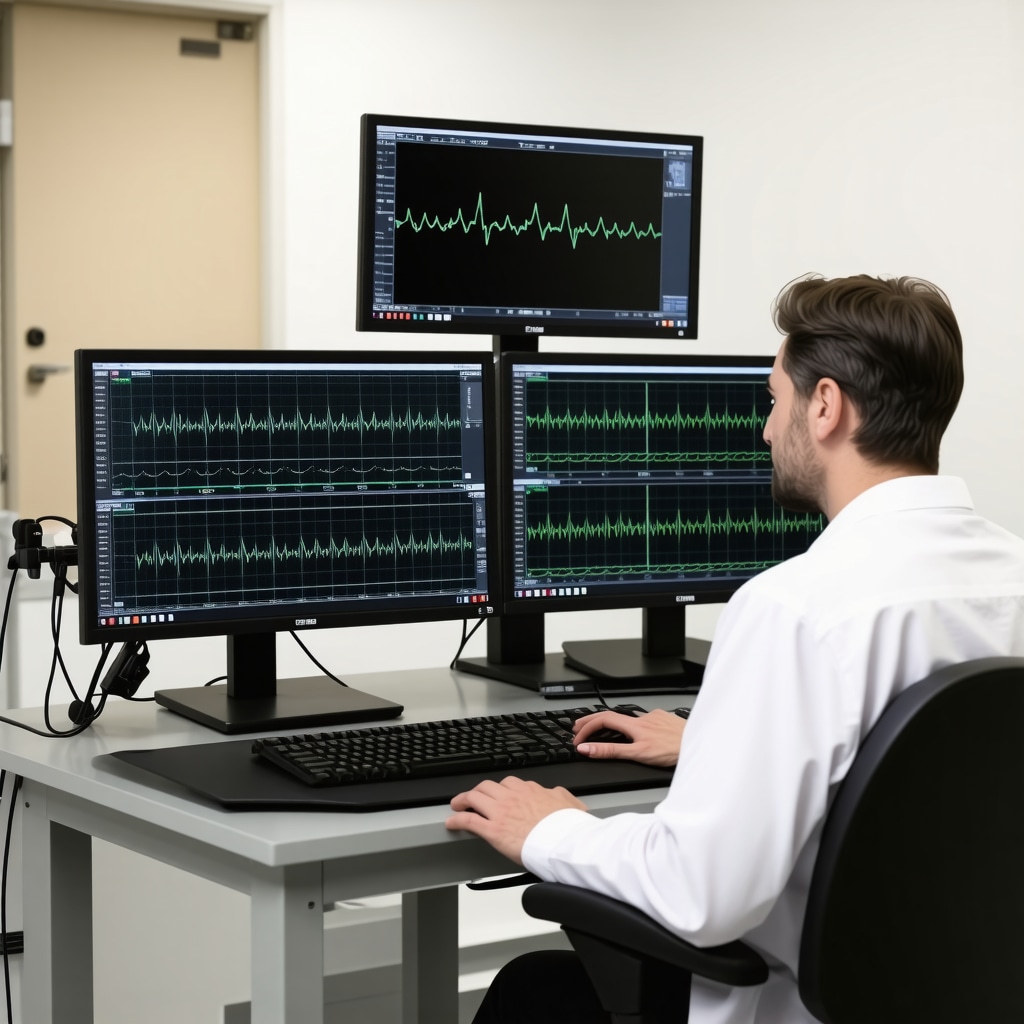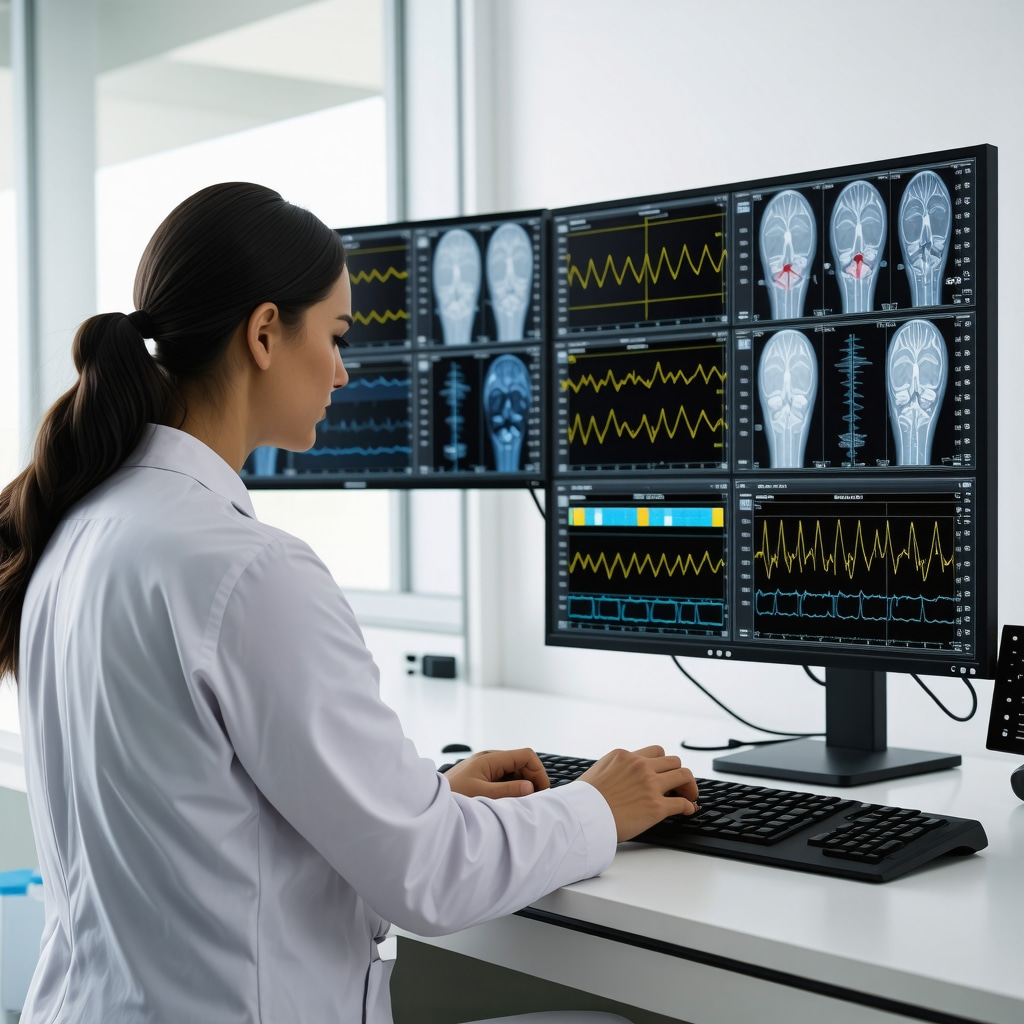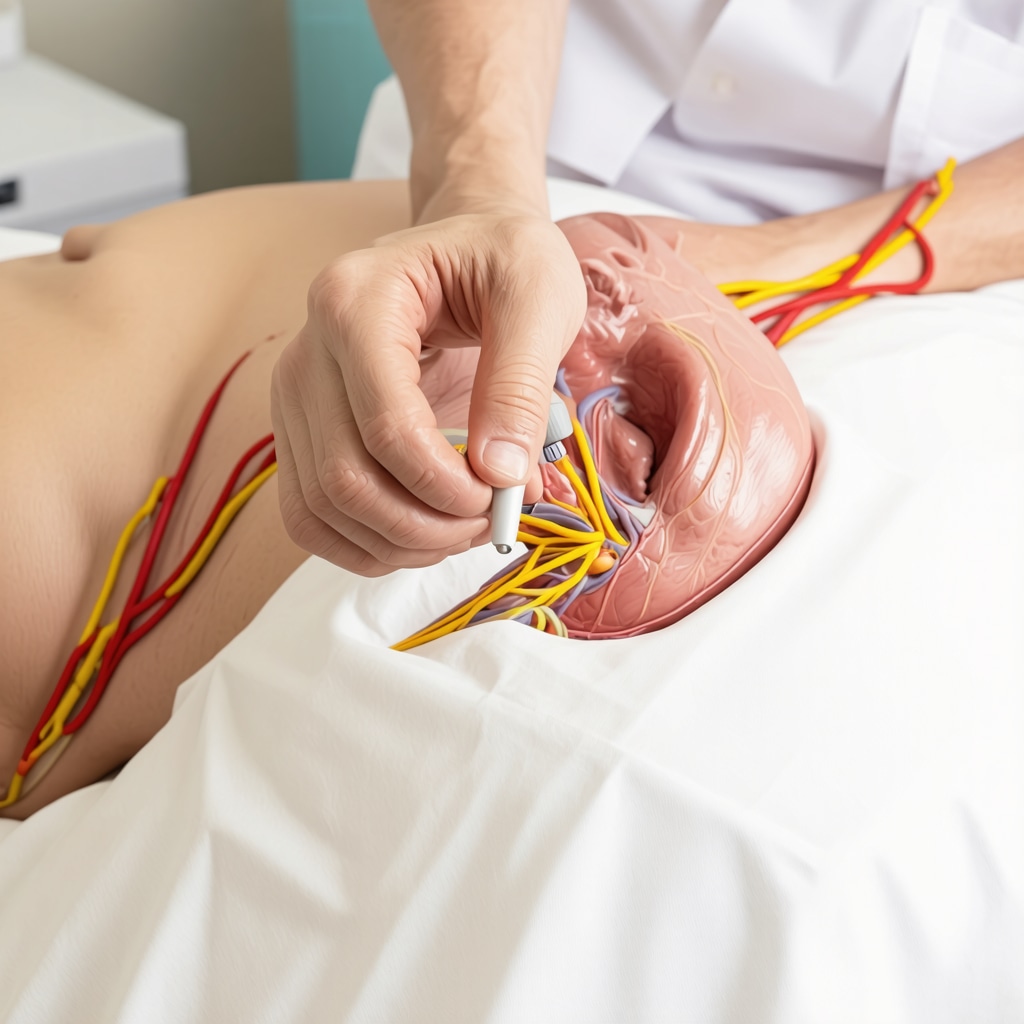Decoding the Language of Nerve Health: Why EMG and NCS Matter in Orthopedics
In the intricate world of orthopedic medicine, understanding nerve function is pivotal for accurate diagnosis and effective treatment. Electromyography (EMG) and Nerve Conduction Studies (NCS) stand as essential investigative tools that offer a window into the electrical activity and health of our nerves and muscles. These tests help clinicians decipher complex symptoms like numbness, weakness, or unexplained pain, which often puzzle both patients and physicians alike.
Electromyography: Listening to Muscles Speak
EMG is a specialized diagnostic technique that measures the electrical signals produced by muscle fibers when they contract. By inserting fine needles into specific muscles, orthopedic specialists can detect abnormal electrical patterns signaling nerve or muscle disorders. For example, in cases of suspected radiculopathy from a herniated disc, EMG can reveal the precise muscles affected by nerve root compression, guiding targeted therapies.
Nerve Conduction Studies: Mapping the Highway of Nerves
NCS complements EMG by evaluating the speed and strength of electrical impulses traveling along peripheral nerves. By placing surface electrodes on the skin, clinicians stimulate nerves and measure the conduction velocity and amplitude of the response. This test is invaluable in diagnosing conditions like carpal tunnel syndrome or peripheral neuropathy, where nerve damage disrupts normal signal flow.
How Do EMG and NCS Together Paint a Complete Neurological Picture?
While EMG focuses on muscle electrical activity, NCS assesses nerve function, making them complementary. Together, they differentiate between muscle diseases, nerve disorders, or neuromuscular junction problems. For instance, a patient with tingling and weakness in the arm might have nerve compression diagnosed via slowed conduction on NCS and muscle denervation shown in EMG. This comprehensive insight informs personalized treatment strategies, whether surgical or conservative.
Practical Insights: What to Expect During Your Nerve Testing Experience
Undergoing EMG and NCS may sound daunting, but understanding their process can ease apprehension. Typically, NCS is performed first, with mild electrical pulses applied to the skin causing brief tingling sensations. EMG follows, involving needle insertions that may cause minor discomfort but provide critical diagnostic data. These tests usually take about 30 to 60 minutes and are conducted by trained neurophysiology technicians or orthopedic specialists.
Expert Guidance: Interpreting Results and Next Steps
Interpreting EMG and NCS results requires expertise, as findings must be correlated with clinical examination and imaging studies. Abnormal results can confirm nerve compression, demyelination, or axonal loss, influencing decisions such as referring to a spine surgeon or initiating non-surgical care. For those interested in conservative management of nerve-related orthopedic conditions, exploring effective non-surgical care for herniated discs can be a valuable next step.
For a deeper dive into the technical aspects and patient preparation, the American Association of Neuromuscular & Electrodiagnostic Medicine provides authoritative guidance and resources.
Have you undergone EMG or NCS testing? Share your experience or questions in the comments below to help others navigate their orthopedic nerve health journey.
My Personal Take on EMG and NCS: Lessons from the Testing Room
Having accompanied a close friend through the maze of nerve testing, I gained firsthand insight into the nuances of EMG and NCS beyond the clinical descriptions. One detail that stood out was how the tests not only pinpoint nerve issues but also help patients mentally prepare for treatment options. For example, after my friend’s EMG showed clear signs of nerve root irritation, the orthopedic doctor could confidently suggest targeted physical therapy, which led to noticeable improvement within weeks.
When Should You Consider EMG and NCS? A Reflective Question
Could these tests be the key to unlocking your unexplained pain?
It’s common to wonder if the numbness, tingling, or weakness you experience warrants these specialized tests. From personal experience and conversations with orthopedic experts, including insights from the initial consultation phase, I learned that EMG and NCS are especially valuable when symptoms persist despite standard imaging like MRI or X-rays. These tests can reveal functional nerve impairments that images alone might miss.
Moreover, they help differentiate whether symptoms arise from peripheral nerve issues, muscle diseases, or even complex neuromuscular junction problems, which require vastly different treatment approaches. For example, a patient with carpal tunnel syndrome benefits from NCS to confirm slowed nerve conduction, guiding decisions about conservative management versus surgery.
Integrating EMG and NCS Results Into Orthopedic Care Plans
In cases I’ve observed, comprehensive test results have steered care plans toward either non-invasive treatments or timely surgical referrals. After a colleague’s NCS confirmed severe nerve compression, she was promptly referred to a spine surgeon, which expedited her recovery timeline. Conversely, for others, such as those managing disc herniation or facet joint pain, combining these diagnostics with effective non-surgical orthopedic care has proven beneficial.
These decisions hinge on expert interpretation, emphasizing the importance of consulting board-certified orthopedic doctors who understand the subtleties in test findings and their practical implications for spine and nerve health.
How Technology and Expertise Converge in Nerve Diagnostics
One fascinating aspect I discovered is how advances in neurodiagnostic technology enhance the accuracy and comfort of EMG and NCS today. Newer equipment offers more precise readings with less discomfort, a fact supported by studies from authoritative bodies like the American Association of Neuromuscular & Electrodiagnostic Medicine (AANEM).
Equally important is the skill of the clinician performing and interpreting these tests. Their expertise can mean the difference between a clear diagnosis and a prolonged, frustrating search for answers. This is why choosing the right orthopedic specialist, such as those recommended in selecting your orthopedic spine surgeon, is critical.
If you’ve experienced EMG or NCS testing or are considering it, I invite you to share your stories or questions in the comments. Your insights could illuminate the path for someone else navigating similar challenges.
Beyond Basics: Leveraging EMG and NCS for Complex Neuropathies and Rare Orthopedic Cases
While EMG and NCS are well-established in diagnosing common nerve entrapments and radiculopathies, their utility extends far deeper, particularly in complex neuropathies and less typical presentations. Conditions like multifocal motor neuropathy, chronic inflammatory demyelinating polyneuropathy (CIDP), and hereditary neuropathies pose significant diagnostic challenges. In such scenarios, advanced neurophysiological techniques such as repetitive nerve stimulation or single-fiber EMG may be incorporated to uncover subtle pathophysiological changes not evident on standard testing.
Moreover, these diagnostic modalities can differentiate between axonal degeneration and demyelination, a distinction critical for prognosis and treatment strategy. For instance, demyelinating neuropathies often respond better to immunomodulatory therapies, whereas axonal damage may necessitate supportive care and symptom management.
Interpreting Ambiguous EMG/NCS Results: Strategies for Orthopedic Specialists
Occasionally, EMG and NCS findings can be equivocal or discordant with clinical symptoms, leaving orthopedic practitioners in a diagnostic quandary. In such cases, a multidisciplinary approach involving neurologists, physiatrists, and radiologists can clarify the clinical picture. Correlation with high-resolution imaging like MR neurography or ultrasound neurography provides anatomical context to electrophysiological data, revealing nerve swelling, entrapment sites, or fascicular changes.
Furthermore, repeat testing after an interval may be warranted when initial results are inconclusive, capturing progression or resolution of nerve pathology. This dynamic assessment aids in tailoring patient-specific interventions while avoiding premature or unnecessary surgeries.
How Do EMG and NCS Contribute to Prognostication and Rehabilitation Planning?
Beyond diagnosis, EMG and NCS offer prognostic insights by quantifying the extent of nerve injury and muscle reinnervation potential. For example, the presence of fibrillation potentials or positive sharp waves on EMG suggests active denervation, indicating ongoing nerve injury that may benefit from urgent intervention. Conversely, evidence of polyphasic motor unit potentials can signal reinnervation and recovery.
These findings directly influence rehabilitation protocols, guiding the intensity and timing of physical therapy, orthotic use, or functional electrical stimulation. An orthopedic specialist well-versed in electrophysiological interpretations can thus orchestrate a comprehensive, evidence-based recovery plan.
For clinicians seeking to deepen their understanding of the nuanced role of EMG and NCS in complex cases, the National Center for Biotechnology Information (NCBI) review on advanced electrodiagnostic techniques offers an authoritative resource.
Integrating Technological Innovations: The Future Landscape of Nerve Diagnostics in Orthopedics
Emerging technologies like high-density surface EMG and automated nerve conduction analytics promise to revolutionize nerve diagnostics by enhancing spatial resolution and reducing operator dependency. Coupled with machine learning algorithms, these advancements are poised to provide real-time, highly reproducible assessments, facilitating earlier diagnosis and personalized treatment plans.
Additionally, wearable neurodiagnostic devices under development could enable continuous monitoring of nerve function in ambulatory settings, offering unprecedented data granularity for chronic condition management.
Such innovations underscore the imperative for orthopedic professionals to remain abreast of technological progress, ensuring optimal patient outcomes through state-of-the-art diagnostics.
Have you encountered complex nerve conditions where EMG and NCS results shaped your treatment decisions? Engage with our expert community by sharing your experiences or posing your questions below—your contributions enrich collective knowledge and patient care strategies.

Refining Diagnostic Precision: When Standard Tests Fall Short
Despite their proven utility, standard EMG and NCS sometimes yield ambiguous results that challenge even seasoned orthopedic specialists. In such instances, integrating complementary diagnostic modalities—such as MR neurography and ultrasonography—can elucidate subtle nerve pathologies like fascicular swelling or compressive neuropathies not readily apparent on electrophysiological testing alone. This multimodal approach enhances diagnostic accuracy and facilitates nuanced clinical decision-making.
Leveraging Electrophysiological Nuances for Tailored Patient Management
Advanced interpretation of EMG/NCS findings enables differentiation between demyelinating and axonal neuropathies, each with distinct therapeutic implications. For example, identifying conduction block or temporal dispersion on NCS can direct immunomodulatory therapy for conditions like chronic inflammatory demyelinating polyneuropathy (CIDP), whereas axonal loss typically warrants supportive rehabilitation. Such granularity in diagnosis empowers orthopedic practitioners to personalize interventions and optimize functional outcomes.
What Are the Cutting-Edge Techniques Enhancing EMG and NCS Diagnostic Yield?
Emerging methodologies, including high-density surface EMG and single-fiber EMG, are transforming the electrophysiological landscape by providing superior spatial and temporal resolution. These innovations allow detection of micro-architectural nerve changes and neuromuscular junction abnormalities with unparalleled sensitivity. Additionally, automated nerve conduction analytics, augmented by machine learning algorithms, offer reproducible and rapid assessments, mitigating operator variability and expediting clinical workflows.
For an in-depth exploration of these advanced electrodiagnostic techniques, the NCBI comprehensive review remains an authoritative resource guiding clinicians through evolving best practices.
Charting the Future: Integrating AI and Wearable Technologies in Neurodiagnostics
The convergence of artificial intelligence with neurodiagnostic tools heralds a new era in orthopedic nerve assessment. AI-powered algorithms can analyze large datasets from high-density EMG and NCS, identifying subtle pathological patterns invisible to the human eye. Moreover, wearable neurodiagnostic devices under development promise continuous, ambulatory monitoring of nerve function, enabling dynamic assessment of disease progression and treatment efficacy in real-world settings.
Orthopedic specialists embracing these technological frontiers will be better equipped to deliver precision medicine tailored to individual neuropathic profiles.
Have you encountered complex neuropathies where advanced EMG and NCS interpretations significantly influenced your clinical decisions? Engage with our expert community by sharing your experiences or posing challenging questions below—your insights foster collective expertise and elevate patient care standards.

Frequently Asked Questions (FAQ)
What exactly do EMG and NCS measure, and how are they different?
Electromyography (EMG) measures the electrical activity generated by muscles during rest and contraction, revealing muscle and nerve health. Nerve Conduction Studies (NCS) assess the speed and strength of electrical signals traveling along peripheral nerves. While EMG focuses on muscle electrical responses, NCS evaluates nerve function, making them complementary diagnostic tools.
When should a patient with orthopedic symptoms consider undergoing EMG and NCS?
These tests are particularly useful when symptoms such as numbness, tingling, or weakness persist despite imaging like MRI or X-rays, or when clinical exams suggest nerve involvement. They help differentiate between nerve compression, muscle disease, or neuromuscular junction disorders, guiding appropriate treatment plans.
Are EMG and NCS painful or uncomfortable?
NCS involves mild electrical stimulations felt as brief tingling or tapping. EMG requires needle insertion into muscles, which may cause minor discomfort or aching. Both procedures are generally well-tolerated and performed by trained professionals to minimize discomfort while obtaining critical diagnostic information.
How do EMG and NCS results influence orthopedic treatment decisions?
Results can confirm the presence, location, and severity of nerve or muscle pathology. For example, slowed conduction velocity on NCS may indicate nerve entrapment warranting surgical decompression, whereas EMG evidence of reinnervation suggests potential for recovery with conservative care. These insights enable tailored interventions from physical therapy to surgery.
Can EMG and NCS detect rare or complex neuropathies beyond common conditions?
Yes, advanced electrodiagnostic techniques, including single-fiber EMG and repetitive nerve stimulation, help diagnose complex neuropathies like chronic inflammatory demyelinating polyneuropathy (CIDP) or multifocal motor neuropathy. Differentiating demyelinating from axonal neuropathies is crucial for guiding immunomodulatory or supportive treatments.
What role do emerging technologies play in enhancing EMG and NCS diagnostics?
Innovations such as high-density surface EMG, automated nerve conduction analytics, and AI-powered interpretation improve spatial resolution, reproducibility, and diagnostic speed. Wearable neurodiagnostic devices under development promise continuous monitoring, enabling personalized management of chronic nerve conditions.
How should ambiguous or inconclusive EMG/NCS results be handled?
In such cases, multidisciplinary collaboration with neurologists and radiologists is essential. Complementary imaging like MR neurography or ultrasound neurography can reveal subtle nerve abnormalities. Repeat testing after an interval may capture progression, aiding refined diagnosis and treatment planning.
Are there specific preparation steps patients should follow before these tests?
Patients should inform clinicians about medications, bleeding disorders, or implanted devices. Typically, no special fasting is required. Wearing comfortable clothes that allow access to tested areas is advisable. Clear communication with the testing team ensures optimal and safe test performance.
Can EMG and NCS provide prognostic information for rehabilitation?
Yes, EMG findings like fibrillation potentials indicate active denervation, guiding urgency of intervention. Evidence of muscle reinnervation informs expected recovery potential and helps customize rehabilitation intensity and timing, including use of orthotics or electrical stimulation.
Who performs and interprets EMG and NCS in orthopedic settings?
Tests are usually conducted by trained neurophysiology technicians under the supervision of board-certified orthopedic specialists or neurologists experienced in electrodiagnostic medicine. Expert interpretation integrated with clinical evaluation is essential for accurate diagnosis and treatment planning.
Trusted External Sources
- American Association of Neuromuscular & Electrodiagnostic Medicine (AANEM): Offers comprehensive guidelines on EMG and NCS procedures, patient preparation, and interpretation standards, ensuring evidence-based clinical practice.
- National Center for Biotechnology Information (NCBI): Provides peer-reviewed articles and detailed reviews on advanced electrodiagnostic techniques and neuropathies, supporting cutting-edge clinical knowledge.
- Orthopaedic Research Society (ORS): Publishes research on musculoskeletal and nerve disorders, highlighting interdisciplinary approaches to orthopedic nerve diagnostics and treatment innovations.
- Radiological Society of North America (RSNA): Offers resources on advanced imaging modalities like MR neurography, complementing electrodiagnostic evaluations for nerve pathology.
- Journal of Clinical Neurophysiology: Features scholarly articles on technological advancements and clinical applications of EMG and NCS, reinforcing diagnostic precision in orthopedic contexts.
Conclusion: Advancing Orthopedic Nerve Health through EMG and NCS
Understanding the intricate interplay between nerves and muscles is fundamental in orthopedic care, and EMG along with NCS provide indispensable insights beyond conventional imaging. These diagnostic tools empower clinicians to pinpoint nerve dysfunction, differentiate complex neuropathies, and tailor individualized treatment strategies ranging from conservative management to surgical intervention.
Technological innovations and expert interpretation continue to enhance the accuracy, comfort, and prognostic value of these tests, shaping future neurodiagnostic landscapes. For patients experiencing persistent neurologic symptoms or those navigating complex orthopedic nerve conditions, proactively discussing EMG and NCS with their specialists can unlock pathways to effective recovery.
Engage with this evolving field by sharing your experiences, posing questions, or exploring related expert content to deepen your understanding and contribute to improved nerve health outcomes.

